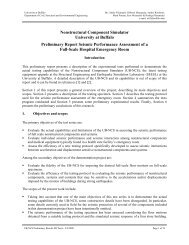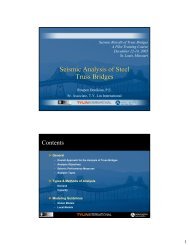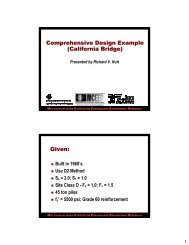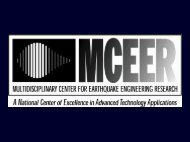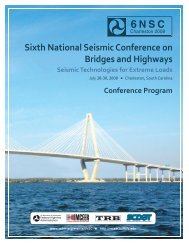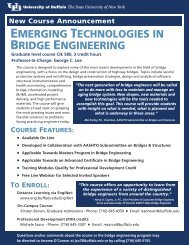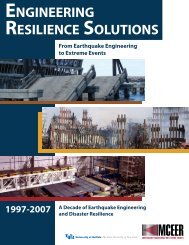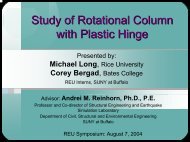Overview of Damage to Buildings Near Ground Zero Overview of ...
Overview of Damage to Buildings Near Ground Zero Overview of ...
Overview of Damage to Buildings Near Ground Zero Overview of ...
Create successful ePaper yourself
Turn your PDF publications into a flip-book with our unique Google optimized e-Paper software.
MCEER Special Report Series<br />
Engineering and Organizational Issues Related <strong>to</strong><br />
the World Trade Center Terrorist Attack<br />
Volume 1<br />
<strong>Overview</strong> <strong>of</strong> <strong>Damage</strong> <strong>to</strong> <strong>Buildings</strong><br />
<strong>Near</strong> <strong>Ground</strong> <strong>Zero</strong><br />
By Michel Bruneau, Andrew Whittaker and Andrei Reinhorn
The Multidisciplinary Center for Earthquake Engineering Research<br />
The Multidisciplinary Center for Earthquake Engineering Research (MCEER) is a national center<br />
<strong>of</strong> excellence in advanced technology applications that is dedicated <strong>to</strong> the reduction <strong>of</strong> earthquake<br />
losses nationwide. Headquartered at the University at Buffalo, State University <strong>of</strong> New York, the Center<br />
was originally established by the National Science Foundation (NSF) in 1986, as the National Center<br />
for Earthquake Engineering Research (NCEER).<br />
Comprising a consortium <strong>of</strong> researchers from numerous disciplines and institutions throughout<br />
the United States, the Center’s mission is <strong>to</strong> reduce earthquake losses through research and the application<br />
<strong>of</strong> advanced technologies that improve engineering, pre-earthquake planning and post-earthquake<br />
recovery strategies. Toward this end, the Center coordinates a nationwide program <strong>of</strong> multidisciplinary<br />
team research, education and outreach activities.<br />
Funded principally by NSF, the State <strong>of</strong> New York and the Federal Highway Administration (FHWA),<br />
the Center derives additional support from the Federal Emergency Management Agency (FEMA), other<br />
state governments, academic institutions, foreign governments and private industry.
MCEER Special Report Series<br />
Engineering and Organizational Issues Related <strong>to</strong><br />
The World Trade Center Terrorist Attack<br />
Volume 1:<br />
<strong>Overview</strong> <strong>of</strong> <strong>Damage</strong> <strong>to</strong> <strong>Buildings</strong> near <strong>Ground</strong> <strong>Zero</strong><br />
By Michel Bruneau, Andrew Whittaker and Andrei Reinhorn<br />
Department <strong>of</strong> Civil, Structural, and Engineering<br />
University at Buffalo<br />
Buffalo, NY 14260<br />
and the<br />
Multidisciplinary Center for Earthquake Engineering Research<br />
Red Jacket Quadrangle<br />
University at Buffalo<br />
Buffalo, NY 14261<br />
March 2002<br />
MCEER-02-SP02<br />
Red Jacket Quadrangle<br />
Tel: (716) 645-3391; Fax: (716) 645-3399; Email: mceer@acsu.buffalo.edu<br />
World Wide Web: http://mceer.buffalo.edu<br />
i
Foreword<br />
The terrorist attack that <strong>to</strong>ok place on September 11, 2001 in New York City<br />
resulted in thousands <strong>of</strong> lives lost, the collapse <strong>of</strong> the twin <strong>to</strong>wers <strong>of</strong> the<br />
World Trade Center as well as damage <strong>to</strong> adjacent buildings, and extensive<br />
disruption <strong>of</strong> transportation and other lifeline systems, economic activity, and<br />
other social activities within the city and the surrounding area. When the<br />
final accounting takes place, this attack will almost certainly constitute one <strong>of</strong><br />
the most deadly and costly disasters in U. S. his<strong>to</strong>ry.<br />
In a very real sense, the September 11 tragedy, the nature <strong>of</strong> the damage that<br />
occurred, the challenges that the city's emergency response community faced,<br />
and the actions that were undertaken <strong>to</strong> meet those demands can be seen as a<br />
"proxy" – albeit a geographically concentrated one – for what a major<br />
earthquake can do in a complex, densely-populated modern urban<br />
environment. Like an earthquake, the terrorist attack occurred with virtually<br />
no warning. As would be expected in an earthquake, fires broke out and<br />
multiple structural collapses occurred. As has been observed in major urban<br />
earthquakes and in other disasters (e.g., Hurricane Andrew), structures<br />
housing facilities that perform critical emergency functions were destroyed,<br />
heavily damaged, or evacuated for life-safety reasons. Additionally, because<br />
the majority <strong>of</strong> the damage occurred <strong>to</strong> relatively new and well-engineered<br />
structures and because the emergency response system in New York City was<br />
considered very well prepared for all types <strong>of</strong> emergencies, particularly<br />
terrorist attacks, the attack and its aftermath provide a useful labora<strong>to</strong>ry for<br />
exploring a variety <strong>of</strong> engineering and emergency management issues.<br />
In this perspective, the Multidisciplinary Center for Earthquake Engineering<br />
Research initiated a research project (funded by the National Science<br />
Foundation) <strong>to</strong> collect perishable data in the aftermath <strong>of</strong> the attack for later<br />
study <strong>to</strong> gain a better understanding <strong>of</strong> how resilience is achieved in both<br />
physical, engineered systems and in organizational systems. The project is<br />
divided in<strong>to</strong> two major components, focusing on the impact <strong>of</strong> the disaster on<br />
engineering and organizational systems:<br />
(a) <strong>Damage</strong> <strong>to</strong> <strong>Buildings</strong> in the Vicinity <strong>of</strong> <strong>Ground</strong> <strong>Zero</strong> – The objective <strong>of</strong><br />
this effort is <strong>to</strong> collect perishable information on the various types <strong>of</strong><br />
damage suffered by buildings at <strong>Ground</strong> <strong>Zero</strong>, including, most<br />
importantly, those that suffered moderate damage from the impact <strong>of</strong><br />
large debris but that did not collapse, and <strong>to</strong> investigate whether state-<br />
iii
iv<br />
<strong>of</strong>-practice analytical methods used in earthquake engineering can be<br />
used <strong>to</strong> explain the observed structural behavior.<br />
(b) Organizational and Community Resilience in the World Trade Center<br />
Disaster – The objective <strong>of</strong> this effort is <strong>to</strong> collect information on the<br />
response activities <strong>of</strong> the City’s Emergency Operations Center and on<br />
other critical emergency response facilities. Of particular interest is <strong>to</strong><br />
identify the plans that were in place at the time <strong>of</strong> the disaster, as well<br />
as how decision systems were used and coordinated with engineering<br />
decisions. Efforts will also include identifying the technologies and<br />
<strong>to</strong>ols that were most useful or failed (or did not meet expectations)<br />
during the emergency period, the types <strong>of</strong> adaptations that had <strong>to</strong> be<br />
made by these organizations, how well intra-organizational<br />
communication and coordination functioned, and whether any<br />
emerging technologies were used during the emergency period.<br />
The MCEER special report series “Engineering and Organizational Issues<br />
Related <strong>to</strong> The World Trade Center Terrorist Attack” was initiated <strong>to</strong> present<br />
the findings from this work. The decision <strong>to</strong> publish a number <strong>of</strong> brief<br />
individual reports focusing on different <strong>to</strong>pics was prompted by the desire <strong>to</strong><br />
provide timely access <strong>to</strong> this information. As such, each report in the series<br />
focuses on a narrow aspect <strong>of</strong> the disaster as studied by MCEER researchers.<br />
A compendium <strong>of</strong> these short reports is planned at a later time. It is hoped<br />
that this work will provide a useful contribution that can lead <strong>to</strong> a better<br />
understanding <strong>of</strong> how <strong>to</strong> cost-effectively enhance the resilience <strong>of</strong> buildings<br />
against catastrophic events.
Acknowledgment<br />
This work was supported primarily by the Earthquake Engineering Research<br />
Centers Program <strong>of</strong> the National Science Foundation (NSF) under a<br />
Supplement <strong>to</strong> Award Number ECC-9701471 <strong>to</strong> the Multidisciplinary Center<br />
for Earthquake Engineering Research. The authors thank Dr. Priscilla Nelson<br />
and Dr. Joy Pauschke <strong>of</strong> NSF for their initiative and support <strong>of</strong> this project.<br />
The authors also thank Messrs. Dan Cuoco, Edward Swierz, Kurt J.<br />
Goodfriend and Emmanuel Velivasakis <strong>of</strong> LZA Technology/Thorn<strong>to</strong>n-<br />
Tomasetti Engineers for their valuable assistance and Jane S<strong>to</strong>yle, MCEER, for<br />
her edi<strong>to</strong>rial assistance in the preparation <strong>of</strong> this report.<br />
v
Contents<br />
1.0 Introduction 1<br />
2.0 Background Information 3<br />
3.0 <strong>Damage</strong> at <strong>Ground</strong> <strong>Zero</strong> 7<br />
3.1 World Trade Center Towers 1 and 2 8<br />
3.2 World Trade Center 3 and 4 14<br />
3.3 World Trade Center 5 and 6 17<br />
3.4 World Trade Center 7 18<br />
3.5 Verizon Building, 140 West Street 22<br />
3.6 Winter Garden and 3 World Financial Center, 200 Vesey Street 24<br />
3.7 90 West Street Building 28<br />
3.8 Banker’s Trust Building, 130 Liberty Street 29<br />
3.9 Examples <strong>of</strong> Architectural <strong>Damage</strong> 32<br />
4.0 Conclusions – Anticipated Progress, Findings, and Benefits<br />
<strong>of</strong> the Research 35<br />
5.0 References 37<br />
vii
1.0 Introduction<br />
This report contributes <strong>to</strong> one <strong>of</strong> the objectives <strong>of</strong> the Multidisciplinary Center<br />
for Earthquake Engineering Research’s (MCEER) investigations undertaken<br />
following the September 11, 2001, attacks on the twin 110-s<strong>to</strong>ry <strong>to</strong>wers <strong>of</strong> the<br />
World Trade Center, in lower Manhattan, New York. That objective is <strong>to</strong><br />
collect preliminary information on the various types <strong>of</strong> damage suffered by<br />
buildings at and around the seven-building complex <strong>of</strong> the World Trade<br />
Center (WTC), including those that suffered moderate damage from the<br />
impact <strong>of</strong> large falling debris but that remained standing, and <strong>to</strong> investigate<br />
whether analytical methods used in earthquake engineering at this time can<br />
be used <strong>to</strong> explain the observed structural behavior. This important work<br />
could lead <strong>to</strong> a better understanding <strong>of</strong> how <strong>to</strong> cost-effectively enhance the<br />
resilience <strong>of</strong> buildings against terrorist attacks.<br />
This report is the first in MCEER’s special series summarizing research<br />
conducted following the attacks. Therefore, it focuses on describing damage<br />
<strong>to</strong> buildings in the immediate vicinity <strong>of</strong> what has been commonly referred <strong>to</strong><br />
as “<strong>Ground</strong> <strong>Zero</strong>” (roughly defined as the center <strong>of</strong> the WTC complex).<br />
Only initial observations are presented here. The purpose <strong>of</strong> this report is not<br />
<strong>to</strong> describe the causes <strong>of</strong> collapse <strong>of</strong> the World Trade Center <strong>to</strong>wers, but<br />
rather <strong>to</strong> describe the general damage that was observed at <strong>Ground</strong> <strong>Zero</strong>.<br />
1
2.0 Background Information<br />
Although the attacks on the <strong>to</strong>wers <strong>of</strong> the World Trade Center have been<br />
reported exhaustively by news media (e.g., Time, Newsweek, Lip<strong>to</strong>n and<br />
Glanz, 2002 and Powell, 2001), a brief summary <strong>of</strong> the events is provided<br />
below.<br />
At 8:45 a.m. on September 11, 2001, hijacked American Airlines Boeing 767,<br />
flight 11, was purposely steered in<strong>to</strong> Tower 1 <strong>of</strong> the World Trade Center, one<br />
<strong>of</strong> the twin 110-s<strong>to</strong>ry high-rise buildings that s<strong>to</strong>od in lower Manhattan. The<br />
plane, flying southward, impacted the North side <strong>of</strong> the <strong>to</strong>wer head-on,<br />
penetrating the building at mid-width <strong>of</strong> the façade, cutting 33 <strong>of</strong> the 59<br />
columns along that façade <strong>of</strong> the building from the 94th <strong>to</strong> the 99th floors.<br />
Eighteen minutes later, another hijacked Boeing 767, United Airlines flight<br />
175, flying northward, hit Tower 2 <strong>of</strong> the World Trade Center, impacting the<br />
eastern third <strong>of</strong> the South façade <strong>of</strong> the <strong>to</strong>wer, badly damaging the building<br />
shell from the 78th <strong>to</strong> the 84th floors. The extent <strong>of</strong> the damage inside the<br />
<strong>to</strong>wers produced by the impact <strong>of</strong> the planes is unknown. However, the<br />
<strong>to</strong>wers withs<strong>to</strong>od the forces <strong>of</strong> the impacts, and remained standing in spite <strong>of</strong><br />
the gross damage caused by the penetrating planes.<br />
In both cases, jet fuel ignited at impact. Debris from the planes and the<br />
buildings were ejected in<strong>to</strong> the adjacent space and buildings, principally in<br />
the directions <strong>of</strong> impact. Some <strong>of</strong> these debris were ablaze (see Figure 2.1).<br />
The fuel-fed fires raged at the s<strong>to</strong>ries where the collisions occurred, and<br />
propagated <strong>to</strong> the s<strong>to</strong>ries above. The extent <strong>of</strong> the spread and intensity <strong>of</strong> the<br />
fires are unknown.<br />
At 9:50 a.m. the South Tower (WTC 2) collapsed. The segment <strong>of</strong> the <strong>to</strong>wer<br />
above the impact area started <strong>to</strong> tilt eastward and then, nearly as a rigid body,<br />
penetrated the s<strong>to</strong>ries below, pushing the building façade outward leading <strong>to</strong><br />
a progressive collapse that demolished all the s<strong>to</strong>ries below <strong>to</strong> the bot<strong>to</strong>m.<br />
The collapse <strong>to</strong>ok between 9 <strong>to</strong> 15 seconds according <strong>to</strong> later reports.<br />
However, it <strong>to</strong>ok 53 minutes after the impact before the progressive collapse<br />
started. At 10:28 a.m., the North Tower (WTC 1) also collapsed, triggered by a<br />
different mechanism. Based on videos (shown by the media in the aftermath<br />
<strong>of</strong> the collapse), the s<strong>to</strong>ries above the impact areas started falling straight<br />
down on the s<strong>to</strong>ries below, while pushing the façade outward, similar <strong>to</strong> the<br />
fall <strong>of</strong> Tower 2 (see Figure 2.2). It <strong>to</strong>ok one hour and forty-three minutes (103<br />
minutes) after the impact before the progressive collapse <strong>of</strong> the North Tower<br />
started.<br />
3
4<br />
AP/Wide World Pho<strong>to</strong>s<br />
Figure 2.1. Explosion following the plane impact in<strong>to</strong> the South Tower
AP/Wide World Pho<strong>to</strong>s<br />
Figure 2.2. Large segments <strong>of</strong> the World Trade Center perimeter frame fell on<br />
adjacent buildings during the collapse <strong>of</strong> the <strong>to</strong>wers<br />
5
3.0 <strong>Damage</strong> at <strong>Ground</strong> <strong>Zero</strong><br />
On September 21 and 23, 2001, visits <strong>to</strong> <strong>Ground</strong> <strong>Zero</strong> were conducted by the<br />
authors <strong>of</strong> this report <strong>to</strong> view the structural damage <strong>to</strong> buildings. At that<br />
time, work underway at the site was focused on the task <strong>of</strong> debris removal.<br />
The arrows in Fig. 3.1 indicate the route followed by the MCEER<br />
reconnaissance team on September 21, 2001. This route follows the edge <strong>of</strong><br />
the debris pile at <strong>Ground</strong> <strong>Zero</strong>. Fig. 3.1 also provides an overview <strong>of</strong> damage<br />
as reported by a team from the Structural Engineers’ Association <strong>of</strong> New<br />
York (SEAoNY), who conducted a rapid evaluation <strong>of</strong> buildings near <strong>Ground</strong><br />
<strong>Zero</strong>. This rapid inspection was conducted for the New York City<br />
Department <strong>of</strong> Design and Construction/Department <strong>of</strong> <strong>Buildings</strong><br />
(DDC/DoB) by members <strong>of</strong> SEAoNY and coordinated by LZA/Thorn<strong>to</strong>n-<br />
Tomasetti <strong>to</strong> establish which buildings were safe <strong>to</strong> reoccupy. For those<br />
buildings rated as having suffered damage, no distinction was made between<br />
structural and architectural damage in the figure.<br />
Figure 3.1. Arrows indicate the route followed by the MCEER reconnaissance team,<br />
superimposed on <strong>to</strong>p <strong>of</strong> a map <strong>of</strong> the street layout by<br />
SEAoNY, LZA/Thorn<strong>to</strong>n-Tomasetti<br />
7
3.1 World Trade Center Towers 1 and 2<br />
The World Trade Center complex consisted <strong>of</strong> seven buildings, including the<br />
twin 110-s<strong>to</strong>ry buildings. These <strong>to</strong>wers were designated as the North Tower<br />
or WTC 1, and the South Tower or WTC 2. These were the target <strong>of</strong> the<br />
terrorist attacks.<br />
The innovative structural framing system that was developed in the 1960s<br />
and used in the construction <strong>of</strong> these <strong>to</strong>wers, was widely described in the<br />
literature at the time <strong>of</strong> their construction (e.g., Hart et al., 1978). In brief, the<br />
lateral loads (primarily wind) on these <strong>to</strong>wers were resisted by an exterior<br />
steel tube that consisted <strong>of</strong> 59 box-section columns on each face, spaced 32”<br />
on center (Figure 3.2). Each <strong>of</strong> these columns was a rectangular hollow<br />
section built-up from plates <strong>of</strong> varying thicknesses and steel grades. The<br />
exterior tube was also constructed in a modular fashion, with each module<br />
consisting <strong>of</strong> three columns spanning over three s<strong>to</strong>ries assembled with short<br />
deep-spandrel beams. Modules were connected <strong>to</strong>gether using bolted splices<br />
<strong>to</strong> transfer shear in beams. They were connected vertically using bolts in the<br />
bearing plates, primarily for alignment. Figure 3.2 shows how the three-s<strong>to</strong>ry<br />
three column perimeter frame modules were installed.<br />
8<br />
Figure 3.2. Perimeter framing <strong>of</strong> the <strong>to</strong>wer<br />
After Hart et al., 1978<br />
Steel frames surrounded the central utility cores (eleva<strong>to</strong>rs, stairways, and<br />
other services). Gravity loads on each floor were resisted by light joist
21 Floor covering<br />
22 In-situ concrete<br />
23 Trough decking<br />
24 Bar joist<br />
25 Electrical services duct<br />
26 Air-conditioning duct<br />
Figure 3.3. Joist floor system <strong>of</strong> the World Trade Center <strong>to</strong>wers<br />
After Hart et al., 1978<br />
After Hart et al., 1978<br />
Figure 3.4. Vertical structural elements and superposed axial stresses due <strong>to</strong> gravity and<br />
lateral loads<br />
9
framing (Fig. 3.3) that enabled large column-free spans, and that transmitted<br />
the floor loads <strong>to</strong> both the central core and the exterior tube system (Fig. 3.4).<br />
Gravity loads on the exterior tube columns were sufficiently large <strong>to</strong> maintain<br />
compression in the columns, even during the design winds<strong>to</strong>rm. The joists<br />
were simply connected (pinned) <strong>to</strong> the exterior tube column using seat-angle<br />
connections.<br />
The only recognizable portions <strong>of</strong> WTC 1 and 2 on September 21, 2001, were<br />
parts <strong>of</strong> the exterior tube described above that remained standing in the<br />
debris pile (Figure 3.5). Some evidence <strong>of</strong> the building modular construction<br />
described in the previous paragraph could be observed from these parts <strong>of</strong><br />
the building structural shell (Figure 3.6). The typical four-bolt column splices<br />
could be also observed (Figure 3.7), along with the hole on the side <strong>of</strong> each<br />
hollow rectangular column that provided access for erection <strong>of</strong> the frames<br />
(Figure 3.7, bot<strong>to</strong>m pho<strong>to</strong>graph). As will be seen in the subsequent sections,<br />
some <strong>of</strong> these three-column modules became multi-<strong>to</strong>n projectiles that<br />
impacted and damaged adjacent buildings as the <strong>to</strong>wers collapsed. The<br />
interior <strong>of</strong> the building shell (see Figure 3.6, <strong>to</strong>p pho<strong>to</strong>graphs) shows some<br />
evidence <strong>of</strong> where the supporting seats were located for the floor joists.<br />
It is not the purpose <strong>of</strong> this report <strong>to</strong> describe the causes <strong>of</strong> collapse <strong>of</strong> WTC 1<br />
and 2. That each <strong>to</strong>wer absorbed the impact <strong>of</strong> a large plane and remained<br />
standing despite gross damage and intense fire, permitting occupants below<br />
the point <strong>of</strong> impact <strong>to</strong> evacuate, is a testimony <strong>to</strong> the skills <strong>of</strong> the engineer <strong>of</strong><br />
record.<br />
10<br />
Figure 3.5. Portions<br />
<strong>of</strong> the perimeter tubes<br />
<strong>of</strong> WTC 1 and 2<br />
remained standing in<br />
the debris pile (as <strong>of</strong><br />
September 21, 2001)
Figure 3.5. (continued).<br />
Portions <strong>of</strong> the perimeter<br />
tubes <strong>of</strong> WTC 1 and 2 that<br />
remained standing in the<br />
debris pile (as <strong>of</strong> September<br />
21, 2001)<br />
11
Figure 3.6. Modular<br />
construction <strong>of</strong> the <strong>to</strong>wers<br />
12
Figure 3.7. Typical four-bolt<br />
column splices and access holes<br />
on the side <strong>of</strong> hollow rectangular<br />
columns<br />
13
3.2 World Trade Center 3 and 4<br />
World Trade Center 3 (WTC 3) served as the Vista Hotel (formerly the<br />
Marriott hotel), and was located at the base <strong>of</strong> the two twin <strong>to</strong>wers,<br />
immediately adjacent <strong>to</strong> and <strong>to</strong> the west <strong>of</strong> WTC 2 and <strong>to</strong> the south <strong>of</strong> WTC 1.<br />
It was effectively destroyed by falling debris from the collapse <strong>of</strong> the <strong>to</strong>wers<br />
(see Figure 3.8). Although the building was a <strong>to</strong>tal loss, the fact that s<strong>to</strong>ries<br />
remain standing, albeit in a state <strong>of</strong> extreme damage, instead <strong>of</strong> being <strong>to</strong>tally<br />
destroyed, could be partly due <strong>to</strong> the fact that the falling debris from the<br />
collapsing <strong>to</strong>wers, for the most part, remained within their plan footprints.<br />
14<br />
Figure 3.8.<br />
Debris falling<br />
destroyed WTC 3
World Trade Center 4 (WTC 4) was similarly impacted by falling debris. The<br />
large permanent deformations (sagging) <strong>of</strong> many beams in that building<br />
(Figure 3.9) can be attributed <strong>to</strong> a combination <strong>of</strong> impact forces from falling<br />
debris and extensive fire damage.<br />
Figure 3.9.<br />
Falling and<br />
burning debris<br />
destroyed<br />
WTC 4<br />
15
16<br />
Figure 3.9. (continued).<br />
Falling and burning debris<br />
destroyed WTC 4
3.3 World Trade Center 5 and 6<br />
World Trade Center 5 (WTC 5) was located somewhat further from the<br />
<strong>to</strong>wers than WTC 3 and 4, and was likely not showered by as much falling<br />
debris as these buildings were. However, parts <strong>of</strong> the building were still<br />
severely impacted. World Trade Center 6 (WTC 6) was immediately adjacent<br />
<strong>to</strong> WTC 1, and suffered tremendous damage. Both buildings were apparently<br />
hit by burning debris following the plane impact, and extensive fire-related<br />
damage was observed. Large heat dis<strong>to</strong>rtion <strong>of</strong> structural members was<br />
observed in WTC 5 (Figure 3.10). Similar damage was also observed in WTC<br />
6 (Figure 3.11).<br />
Figure 3.10. Fire related damage <strong>to</strong> WTC 5<br />
17
18<br />
Figure 3.11. Impact and fire-related damage <strong>to</strong> WTC 6<br />
3.4 World Trade Center 7<br />
The 47-s<strong>to</strong>ry World Trade Center 7 (WTC 7) was the third tallest building in<br />
the World Trade Center complex. The New York City Emergency Operations<br />
Center was housed in the building, with state-<strong>of</strong>-the-art emergency response<br />
facilities. The building was evacuated after the planes impacted the twin<br />
<strong>to</strong>wers, and before the <strong>to</strong>wers collapsed.<br />
At 5:25 p.m. on September 11, 2001, WTC 7 collapsed as a consequence <strong>of</strong><br />
damage and uncontrolled fire. The resulting debris pile was approximately<br />
seven s<strong>to</strong>ries high (Figure 3.12). Little reliable information on the collapse<br />
sequence can be surmised from the debris. Portions <strong>of</strong> conventional steel<br />
moment-resisting frames were observed in the debris pile (Figure 3.13), as<br />
well as dis<strong>to</strong>rted segments <strong>of</strong> beam stubs welded <strong>to</strong> columns with bolted<br />
splices a few feet away from the columns (Figure 3.14).
Figure 3.12. WTC 7 collapsed as a consequence <strong>of</strong> damage and uncontrolled fire<br />
Figure 3.13. Portions <strong>of</strong> conventional steel moment-resisting frames were observed<br />
in the debris pile<br />
19
20<br />
Figure 3.14 Dis<strong>to</strong>rted segments <strong>of</strong> beam stubs welded <strong>to</strong> the columns<br />
As WTC 7 collapsed, it fell partly on an adjacent building at 30 West<br />
Broadway, causing significant damage (Figure 3.15, south face and Figure<br />
3.16, west face). Beams were permanently dis<strong>to</strong>rted by the impact (Figure<br />
3.17).<br />
Figure 3.15. <strong>Damage</strong> <strong>to</strong> the south face <strong>of</strong> a building at 30 West Broadway<br />
due <strong>to</strong> impact from the collapse <strong>of</strong> WTC 7
Figure 3.16 <strong>Damage</strong> <strong>to</strong> the west face <strong>of</strong> a building at 30 West Broadway due <strong>to</strong> impact<br />
from the collapse <strong>of</strong> WTC 7<br />
21
22<br />
Figure 3.17. Beams in the building at 30 West Broadway were permanently<br />
dis<strong>to</strong>rted by the impact <strong>of</strong> falling debris<br />
3.5 Verizon Building, 140 West Street<br />
The collapse <strong>of</strong> World Trade Center 7 damaged the adjacent Verizon<br />
building. <strong>Damage</strong> <strong>to</strong> the west façade <strong>of</strong> that building is shown in Figure 3.18.<br />
Large segments <strong>of</strong> the WTC 7 braced framing were lodged against the<br />
Verizon building, which also suffered notable perforations in its framing and<br />
cladding. In particular, a steel column was severely dis<strong>to</strong>rted, presumably by<br />
debris impact (Figure 3.18, bot<strong>to</strong>m right pho<strong>to</strong>).<br />
Limited relatively minor damage was also observed <strong>to</strong> the south façade,<br />
possibly produced by debris from the collapse <strong>of</strong> WTC 1 (Figure 3.19).
Figure 3.18. <strong>Damage</strong> <strong>to</strong> the west façade <strong>of</strong> the Verizon Building<br />
23
24<br />
Figure 3.19. Minor damage <strong>to</strong> south façade <strong>of</strong> the Verizon building<br />
3.6 Winter Garden and 3 World Financial Center, 200 Vesey Street<br />
A number <strong>of</strong> the perimeter column modules (see Figure 3.2) from the<br />
collapsing <strong>to</strong>wers penetrated the façade <strong>of</strong> 3 World Financial Center,<br />
significantly damaging the building’s outer shell (see Figure 3.20). Parts <strong>of</strong><br />
perimeter-column modules from one <strong>of</strong> the <strong>to</strong>wers were still protruding from<br />
the façade <strong>of</strong> the World Financial Center <strong>to</strong>wer during the two site visits.<br />
These pieces <strong>of</strong> debris had been secured <strong>to</strong> the building at the time <strong>of</strong> the first<br />
visit on September 21, awaiting a solution <strong>to</strong> remove them without<br />
jeopardizing the integrity <strong>of</strong> the gravity-load-resisting system.<br />
The Winter Garden, located between the two <strong>to</strong>wers <strong>of</strong> World Financial<br />
Center, was severely damaged as numerous pieces <strong>of</strong> debris penetrated the<br />
glass-ceiling <strong>of</strong> this steel-framed building (see Figure 3.21).
Figure 3.20. <strong>Damage</strong> <strong>to</strong> the<br />
façade <strong>of</strong> 3 World Financial<br />
Center<br />
25
Figure 3.20. (continued) <strong>Damage</strong> <strong>to</strong> the façade <strong>of</strong> 3 World Financial Center<br />
26
Figure 3.21.<br />
Severe damage <strong>to</strong><br />
the east side <strong>of</strong> the<br />
Winter Garden<br />
27
3.7 90 West Street Building<br />
The 90 West Street building was hit by burning debris from the collapse <strong>of</strong><br />
World Trade Center 2, which started a number <strong>of</strong> small fires as evinced by<br />
damage <strong>to</strong> the façade (Figure 3.22). A large multi-<strong>to</strong>n segment <strong>of</strong> the façade<br />
<strong>of</strong> WTC 2 lodged at the base <strong>of</strong> the building, but caused only modest damage<br />
<strong>to</strong> the building (Figure 3.23).<br />
28<br />
Figure 3.22. 90 West Street building
Figure 3.23. Large multi-<strong>to</strong>n segment <strong>of</strong> the<br />
façade <strong>of</strong> the WTC 2 lodged at base <strong>of</strong> the 90 West<br />
Street building<br />
3.8 Banker’s Trust Building, 130 Liberty Street<br />
The Banker’s Trust Building at 130 Liberty Street was badly damaged by<br />
falling debris from the collapse <strong>of</strong> World Trade Center 2 (Figure 3.24). A<br />
large piece <strong>of</strong> debris, a perimeter column module from WTC 2, that was still<br />
lodged in the 6 th s<strong>to</strong>ry <strong>of</strong> the building at the time <strong>of</strong> the site visits, ripped a<br />
twenty s<strong>to</strong>ry gash in the north façade <strong>of</strong> the building, from the 26 th <strong>to</strong> the 6 th<br />
s<strong>to</strong>ry (see Figure 3.25), obliterating a column from the perimeter frame at that<br />
location, with much interior damage (see Figure 3.26).<br />
Volume 2 in this MCEER special report series will present a detailed<br />
description <strong>of</strong> the damage <strong>to</strong>, and structural performance <strong>of</strong> this building,<br />
using information from the September 23, 2001, reconnaissance visit.<br />
29
30<br />
Figure 3.24. Banker’s Trust Building, 130 Liberty Street<br />
Figure 3.25. Twenty s<strong>to</strong>ry gash in<br />
the north façade <strong>of</strong> the building, from<br />
the 26 th <strong>to</strong> the 6 th s<strong>to</strong>ry
Figure 3.26. Exterior and interior damage<br />
<strong>to</strong> the Banker’s Trust Building<br />
31
3.9 Examples <strong>of</strong> Architectural <strong>Damage</strong><br />
In some instances, extensive nonstructural damage was observed in the<br />
absence <strong>of</strong> visible structural damage. For example, all the windows were<br />
broken in a building immediately located across from the collapsed World<br />
Trade Center 7. Two World Financial Center exhibited similar damage<br />
(Figure 3.27). However, in some instances, many <strong>of</strong> these windows were also<br />
broken by the fire-fighting crews. The Millennium Hil<strong>to</strong>n, across Church<br />
Street from WTC 5, suffered major cladding damage, but appeared <strong>to</strong> be<br />
otherwise structurally sound (Figure 3.28).<br />
32<br />
Figure 3.27. Broken windows in 2 World Financial Center<br />
Finally, although the miscellaneous debris were removed from the street by<br />
the time <strong>of</strong> the reconnaissance visit, some assessment <strong>of</strong> the quantity <strong>of</strong> dust<br />
and miscellaneous debris that probably littered the entire site on September<br />
11 was provided by the amount <strong>of</strong> such debris still present at less accessible<br />
locations, such as in the emergency stairs <strong>of</strong> a small building adjacent <strong>to</strong><br />
<strong>Ground</strong> <strong>Zero</strong> (Figure 3.29). Among the debris from the <strong>to</strong>wers was a<br />
substantial amount <strong>of</strong> paper, which accumulated on the outside windows <strong>of</strong><br />
buildings in the area.
Figure 3.28. Cladding damage <strong>to</strong> the<br />
Millennium Hil<strong>to</strong>n<br />
Figure 3.29. Debris in the emergency stairs <strong>of</strong> a small building near<br />
<strong>Ground</strong> <strong>Zero</strong><br />
33
4.0 Conclusions - Anticipated<br />
Progress, Findings, and Benefits <strong>of</strong> the<br />
Research<br />
The mission <strong>of</strong> MCEER is <strong>to</strong> help make communities, organizations, and<br />
other social units more resilient in the event <strong>of</strong> earthquakes and other<br />
disasters, including those caused by human actions. In that perspective, the<br />
information and damage overview presented in this report will be used in<br />
subsequent research activities <strong>to</strong> contribute <strong>to</strong> MCEER’s mission by using<br />
earthquake engineering <strong>to</strong>ols <strong>to</strong> assess the resilience <strong>of</strong> buildings <strong>to</strong> terroristinduced<br />
blasts as well as impacts from collapsing buildings. This research<br />
will provide an unprecedented opportunity <strong>to</strong> develop a deeper<br />
understanding <strong>of</strong> the blast-resilience <strong>of</strong> structural systems, which can in turn<br />
lead <strong>to</strong> the development <strong>of</strong> effective measures <strong>to</strong> significantly enhance this<br />
resilience nationwide.<br />
The data collected from these efforts could also have a long-term positive<br />
impact on research activities on the protection <strong>of</strong> critical buildings with<br />
respect <strong>to</strong> (1) understanding dynamic loading conditions (including<br />
shockwave and temperature) on buildings, (2) collapse mechanisms<br />
(including the changes <strong>of</strong> material properties due <strong>to</strong> fire), (3) post-event<br />
debris hazards and removal, and (4) development <strong>of</strong> retr<strong>of</strong>it strategies for<br />
buildings with multiple objectives (e.g., resistance <strong>to</strong> earthquake, blast, fire,<br />
and possibly other hazards).<br />
35
5.0 References<br />
Hart, F., Henn, W. and Sontag, H., 1978, Multis<strong>to</strong>ry <strong>Buildings</strong> in Steel, Granada<br />
Publishing Limited, English translation, ISBN 0-258-969761.<br />
Lip<strong>to</strong>n, E. and Glanz, J., 2002, First Tower <strong>to</strong> Fall Was Hit at Higher Speed, Study<br />
Finds, February 23, NYTimes.com.<br />
Newsweek Extra Edition, 2001, Volume CXXXVIII, No. 12-A, 66 pages,<br />
September.<br />
Powell, A.E., 2001, “September Eleventh: The Days After, The Days Ahead,”<br />
Civil Engineering, November.<br />
Time Magazine, September 23, 2001 issue.<br />
37
Acknowledgements<br />
This report was prepared by the Multidisciplinary Center for Earthquake Engineering Research through<br />
a grant from the Earthquake Engineering Research Centers Program <strong>of</strong> the National Science Foundation<br />
(supplement <strong>to</strong> award number EEC-9701471), funding from New York State, and other sponsors.<br />
The material herein is based upon work supported in whole or in part by the National Science<br />
Foundation, New York State and other sponsors. Opinions, findings, conclusions or recommendations<br />
expressed in this publication do not necessarily reflect the views <strong>of</strong> these sponsors or the Research<br />
Foundation <strong>of</strong> the State University <strong>of</strong> New York.
University at Buffalo The State University <strong>of</strong> New York




